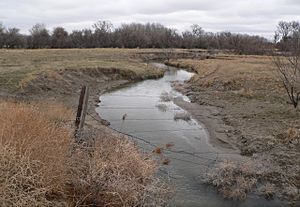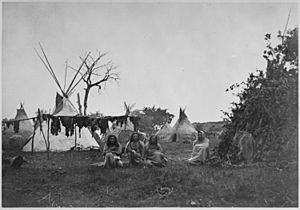Battle of Rush Creek facts for kids
Quick facts for kids Battle of Rush Creek |
|||||||
|---|---|---|---|---|---|---|---|
| Part of the Colorado War | |||||||
 Cedar Creek, formerly Rush Creek, near its confluence with the North Platte |
|||||||
|
|||||||
| Belligerents | |||||||
| United States Army | Cheyenne, Lakota Sioux, and Arapaho tribes | ||||||
| Commanders and leaders | |||||||
| Lt. Col. William O. Collins | George Bent | ||||||
| Strength | |||||||
| 185 soldiers | 1,000 warriors | ||||||
| Casualties and losses | |||||||
| 2-3 killed, 9 wounded | 1+ killed, 2 wounded | ||||||
The Battle of Rush Creek happened on February 8–9, 1865. It was a fight between about 185 soldiers from the U.S. Army and 1,000 warriors. These warriors were from the Lakota Sioux, Cheyenne, and Arapaho tribes. The battle took place near what is now Broadwater, Nebraska. It happened along the North Platte River. The battle did not have a clear winner.
Why the Battle Happened
After an event called the Sand Creek massacre in November 1864, many Plains Indians decided to move. The Cheyenne, Lakota, and Arapaho tribes wanted to go north. They aimed for the Powder River Country in Wyoming and Montana.
On their way, they sought revenge for the Sand Creek event. They raided areas along the South Platte River in Colorado. They also burned the town of Julesburg on February 2. From February 4–6, they attacked a stagecoach station. This was during the Battle of Mud Springs.
The tribes then left that battle to continue their journey north. They crossed the North Platte River on the ice. They set up camp among some bluffs about 5 miles north of the river.
Lt. Col. William O. Collins led about 140 to 185 soldiers. They left Mud Springs on February 8 to find the tribes. The tribes included many women and children, possibly 4,000 to 5,000 people in total. They had gathered a lot of food and supplies from their raids. This allowed such a large group to stay together.
Collins found their old camp on Rush Creek (now Cedar Creek). It was spread out over several miles. The camp was full of items taken from their raids. These included empty cans of oysters, meat, and fruit. He followed their trail north to the North Platte River. Across the river, he saw the tribes' large herds of horses.
The tribes did not expect the smaller group of soldiers to follow them. They had planned to stay at their camp for four days. This was to rest their horses. After that, they would travel 40 miles through the Nebraska Sand Hills without water. Young men and women had been dancing all night and were asleep. But at 2:00 pm, a Sioux warrior signaled from a hilltop. He warned that soldiers were coming. About 1,000 warriors quickly got on their horses. They crossed the flat Platte Valley to fight the soldiers.
The Fight at Rush Creek
Collins saw the large number of warriors coming. He quickly arranged his wagons and horses into a circle. He had his soldiers dig defensive pits. They set up defense lines among the sandy hills on the plain. The warriors crossed the North Platte River both above and below the soldiers. They tried to capture the soldiers' horses. This forced the soldiers to fight on foot.
A long-distance shooting battle began. The soldiers used a howitzer, which is a type of cannon. Its shots kept the warriors at a distance. However, many of the cannon shells did not work correctly.
One group of warriors got very close. Collins ordered 17 men, led by Lt. Patton, to charge them. Collins reported that this charge was successful. But two soldiers were killed. One was Private William H. Hartshorn. His body was found with many arrows. George Bent, a Cheyenne warrior, said the soldiers quickly retreated. He said they had many losses after the warriors charged back. A young Cheyenne named Yellow Nose was hurt in this action. Yellow Nose later captured Lt. Col. George A. Custer's flag. This happened during the Battle of the Little Bighorn.
The warriors pulled back in the late afternoon. Collins' soldiers stayed in their defensive spots overnight. The next morning, several hundred warriors returned. They tried to attack Collins again and capture his horses. After several hours of long-distance shooting, the warriors stopped fighting.
Collins reported two soldiers killed and nine wounded. Another 10 men suffered from frostbite. He guessed that the tribes had 100-150 casualties in both the Mud Springs and Rush Creek battles. George Bent, however, said only two warriors were wounded at Rush Creek. Collins told a detailed story of one warrior who died. Bent told a detailed story of a third soldier, a messenger, who was killed.
After the Battle
The Sioux, Cheyenne, and Arapaho tribes left their camp on February 9. They headed north. Many of their warriors were still keeping Collins' soldiers busy. Collins did not continue chasing them. He said it would have been "unwise and useless." On February 10, he started the journey back to Fort Laramie.
In 10 days, his men had traveled almost 400 miles. They had fought two battles. They were very tired, cold, and hungry. People at the time thought the battle had been a big blow to the tribes. However, one soldier said the warriors were "well armed, well mounted, cunning and brave." Another soldier said catching the tribes was easy, but "we had a terribly hard time letting them go."
The tribes crossed the Sand Hills in two long, difficult days. They then moved west toward the Powder River. They sent messengers ahead to tell their relatives in that area they were coming. Once they were sure no soldiers were following them, the large group split up. Each tribe joined its own relatives in the north. They did not have any more fights with soldiers until June.
Historian George E. Hyde called the tribes' march north "an amazing feat." He noted that these tribes moved 400 miles during a very cold winter. They traveled through open, empty plains. They brought their women and children, their homes (lodges), and all their belongings. They also brought their huge herds of ponies and captured cattle. Along the way, they killed more white people than the number of Cheyenne killed at Sand Creek. They also completely destroyed 100 miles of the Overland Stage Line.
Finding the Battle Site
The place where the battle happened was found in the summer of 2008. Local people led a group of archaeologists from the University of Nebraska–Lincoln to a possible site. This group was led by Peter Bleed and Doug Scott. During the summers of 2008 and 2009, they found over 225 old items. This convinced the researchers that they had indeed found the battle location.
The site was added to the National Register of Historic Places in 2011. It is known as the "Rush Creek Battlefield."


